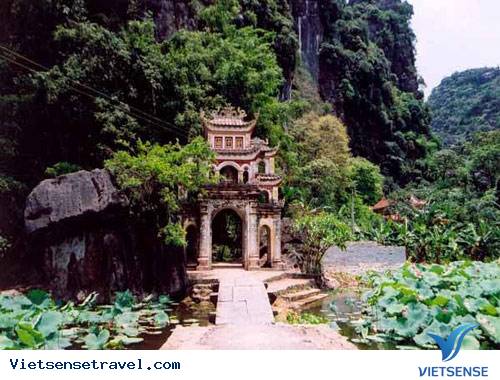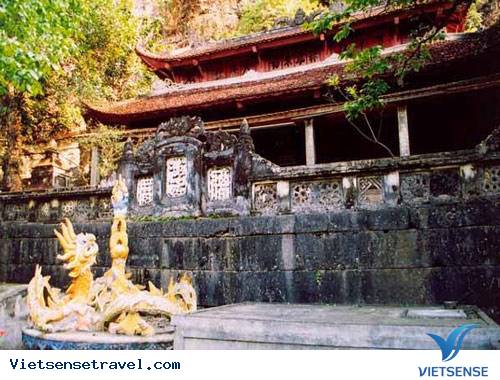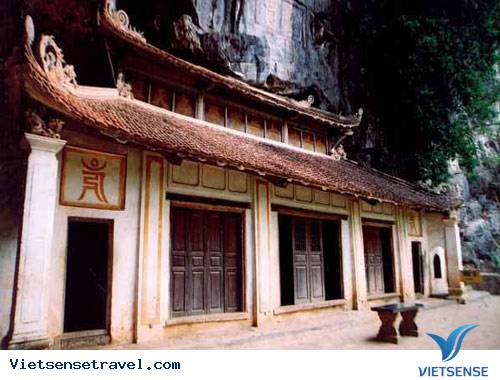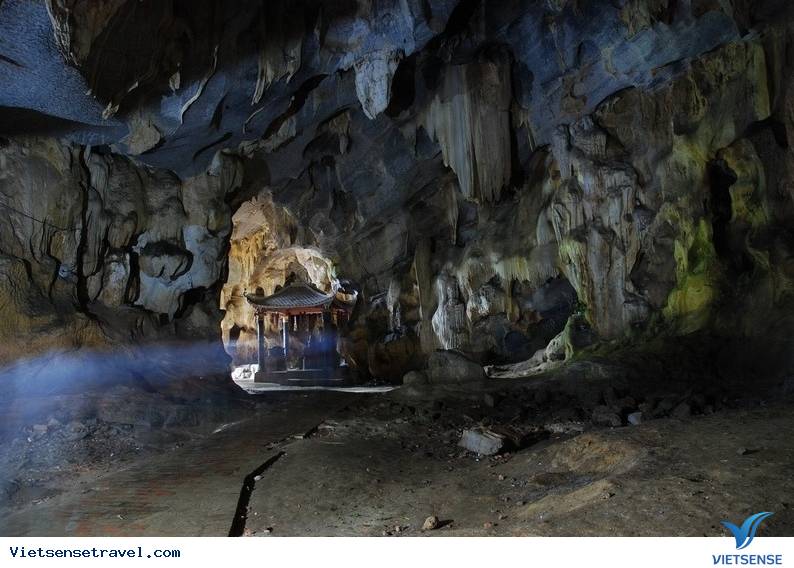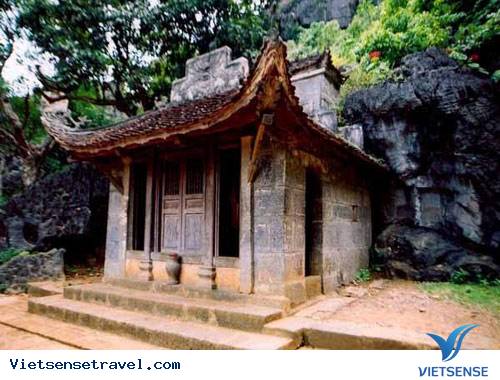Bich Dong Pagoda was built on the slopes of Bich Dong mountain in Dam Khe village, Ninh Hai commune, Hoa Lu district. Bich Dong is one of the most famous landscapes of Ninh Binh province and is known as “Nam Thien De Nhi Dong”, which means the second most beautiful cave in the South, after Huong Tich cave in Ha Tay.
During the reign of King Le Du Tong, reigned Vinh Thinh, around 1705, there were two monks, whose legal names were Tri Kien and Tri The, a native of Vong Doanh, a native of Dong Xuyen of Nghia Hung district, province. Nam Dinh met to become brothers. Both monks are devout and want to go to many places to spread Buddhism and build temples. Coming here, seeing that Bich Dong mountain has a beautiful terrain and already has a pagoda, the two monks decided to stop, repair the old pagoda by themselves, go to the temple and rebuild it into 3 temples: Lower, Middle and Upper to practice. .
In the year of Dinh Hoi (1707), two monks, Tri Kien and Tri The, cast a large bell, which is still hanging in Dark Cave. Two years later (1709), in the 8th month (lunar calendar), two monks again made the inscription of Bich Dong pagoda in Chinese characters. Around the year Giap Ngo (1774), Tinh Do Vuong Trinh Sam visited the pagoda and named it. for the pagoda is Bich Dong pagoda (Bich Dong means green cave).
The way to the temple
Bich Dong Pagoda is an ancient architectural work like other temples. But the unique thing of Bich Dong Pagoda is that it was built in the style of “Tam” (Han characters), three non-contiguous buildings, three levels along the mountainside, based on the mountain position from low to high into 3 separate temples: Lower Pagoda, Middle Pagoda and Upper Pagoda.
Ha Pagoda
Like other pagodas, the architecture of Ha pagoda is in the style of the word “Dinh”, the horizontal part is the front hall with 5 compartments, the vertical part is the upper hall with 2 compartments, with ironwood pillars and tall stone pillars. The trusses, crossbars, and vertical beams are also made of ironwood. The roof of the pagoda is two tiers of curved roofs, including 8 roofs. Because the pagoda’s floor is nearly 1 meter higher than the temple yard, you have to step up 3 stone steps, so the pagoda has an extra porch, creating another low roof, looking at the front as if there are 3 roofs.
Through the porch of the pagoda, you can go through the wooden door to enter the front hall. At the top of the front hall, there is a great picture in Chinese characters “Mao ancient god Thanh” which means that the appearance of this ancient temple is very sacred. In the upper hall is a place to worship Buddha, there are pedestals from above to low, placing Buddha statues and worshiping objects such as incense tops, lamps…
Trung Pagoda
From Ha Pagoda, turn to the right, walk about 90 stone steps along the mountainside in the shape of the letter “S” to reach Trung Pagoda. The height difference from Ha Pagoda to Trung Pagoda is 30 meters. The cliff here is hollow, as wide as a dragon’s mouth is wide open. The dragon’s upper jaw is the rocks that race out like the eaves of a house. The lower jaw of the dragon was flattened, and a balcony was built as the wall of the temple yard. The dragon’s throat is a large, wide, deep cave contained within a temple.
Standing in the courtyard of Trung Pagoda, looking up, saw the stone roof on the mountainside covering the whole yard. On the roof of Trung Pagoda on the vertical cliff, there is a great stone carving carved with two kanji characters “Bich Dong”, written in a genuine way. On the side of Bich Dong, there is a small inscription “Nhat Nam Nguyen editor” (the autograph of the head of Nhat Nam at that time, Lord Trinh Sam, who named the pagoda Bich Dong), and there is the word “Nguyen Nghiem sub. topic”. It is known that to engrave these words, the artisans have to work continuously for 8 months to complete.
Step up 21 stone steps, about 6 m high to reach Dark Cave, formerly known as Chua Cave, because there is Buddha worship in the cave. This is the main cave, solemn, quiet, long, slightly to the east.
Dark Cave
If the cave containing Trung Pagoda is the first floor of a house 6 meters high, then Dark Cave is the second floor up to 8 meters high. The road to Dark Cave is nearly vertical, go under the bridge of justice, because the cave door is shaped like a rainbow. Above the cave door hangs a large bronze bell cast by two monks, Tri Kien and Tri The, in 1707.
Dark Cave is a long, wide space with electric lighting. Before the eyes of visitors is a monumental, massive picture that magically appears in the magical light, in which is carved in stone the figures of the ancestors, fairies, tieu Dong… elaborate, meticulous, and refined. delicate, sharp down to every little detail. And here are the gliding dragons, swimming turtles, adoring elephants, tigers, eagles, vaults, granaries, as unique in shape and beauty.
Everything is like a petrified fairy world, making visitors surprised by the fairy beauty of the Creator. Near the door of Dark Cave in front of visitors is the statue of Buddha Amitabha, the statue of Manjushri Bodhisattva. On the left is Quan Am Thi Kinh. Coming to the entrance of the cave, on the left hand side of the visitor is a small cave, high above worshiping Quan The Am Bodhisattva. Under the floor of this small cave, there are stalactites like turtles and especially two strange rock blocks that sound like a muzzle, one rock hears the bass sound, the other one listens to the sound. Dark Cave is also a Buddhist temple. It is a natural temple.
Upper Temple
Going to Thuong Pagoda, you have to step up to nearly 40 stone steps along the mountainside. Coming here, visitors meet a small pagoda on a mountainside, about 60 meters higher than the underground brick yard. Thuong Pagoda is also known as the East Pagoda because it faces the southeast direction. The north and south sides of the pagoda are built of ruler stone, the west side of the pagoda is close to the cliff, taking the mountain as the wall.
The pillars, grate, and truss of the pagoda are made of ironwood, the roof is curved, and the blade is curved up like a phoenix. The pagoda has 2 compartments in the style of vertical houses, the outer space is the front hall with a large slate altar. In the inner space, there is a single statue of Buddha, Quan Am. This is the temple located in the highest position, near the top of Bich Dong mountain.
There are two shrines on either side of the temple. The temple turns to the north to worship Son Than. The temple turns to the south to worship Tho Dia. The temple yard is built with a balcony. Standing here in the summer, the cool wind blows, if you look far to the east, you will see that there are 5 independent mountains standing in front of Bich Dong mountain, looking like 5 lotus petals, called Ngu Nhac Son very meaningful. the meaning of the Buddha scene, including Tam Sang mountain, Gia Dinh mountain, Con Lon mountain, Dau Cau mountain and Hang Based mountain.
Looking down at the Ngu Mon field is the book stack mountain, the elephant mountain. In the past, around the Upper Pagoda in Bich Dong mountain, there was a rare flower. That is Painted chrysanthemum, tiny, yellow petals. Take flowers to mix with tea to drink, eyes will light up, only in Bich Dong and Duc Thuy mountains in Ninh Binh city, but today this precious medicine is no longer available.
Source: Collected internet.
